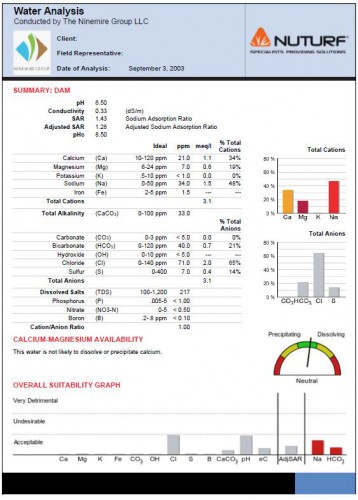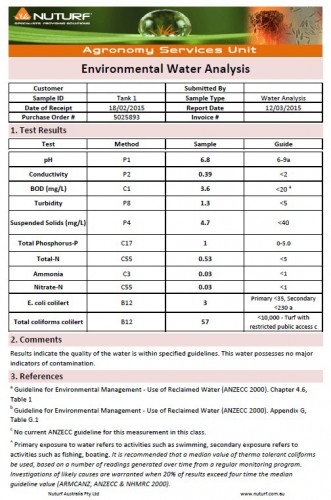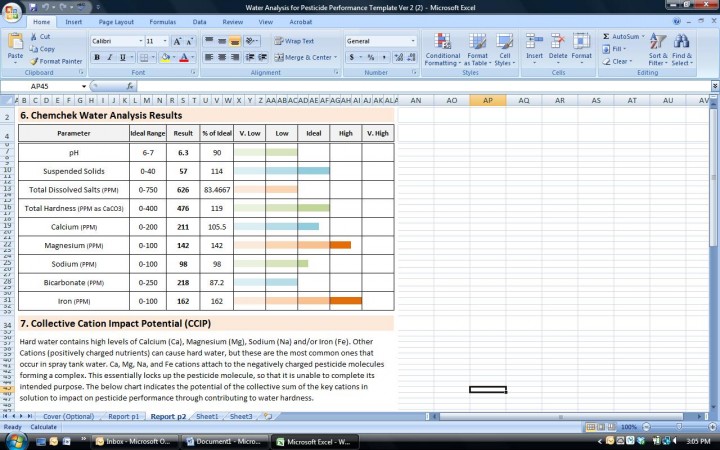Irrigation Water Quality: Summer Issues and Watch Outs
Late Australian summers are normally a challenging period for golf course managers. The accumulation of hot dry conditions tests bent green resilience while summer storms can have an impact on irrigation water quality. Downpours and heavy rain from storms that replenish on-site water supplies seem to get less reliable, and the flushing of soils and recharging of dams occurs less frequently.
Dams catch on site water and often are ‘shandied’ with alternate sources to maintain supply and site viability. Both sources can bring with them variable components that diminish or change water quality. This is where the monitoring and management of water quality over time is vitally important. Soils become a product of their environment as it takes on the attributes of the water sources they are irrigated with. Fortunately in most situations, this can be managed.

The reality of accessing and using alternate water sources
Many water sources get accessed to provide irrigation for turf. Sometimes they supplement town supplies, other times they temporarily replace town supplies. More frequently nowadays they are utilised independent of town supplies. The nature of the source will often indicate which issues the source will be predisposed to but seasonal changes driven by changing environmental conditions can cause significant changes themselves. For example, when dry environmental conditions extend over a long period of time sources such as dams and bores do change in their characteristics. At the commencement of spring and summer 2019 reports of dams and underground sources running low were common, and as a consequence we also saw some of the deleterious elements of those supplies becoming increasingly problematic. Salt concentrations were rising, suspended solids concentrated considerably, changing both the overall quality of the water and the ‘risk’ it conferred to plant and soil health. What were previously low risk waters because the soil accumulation of salts was slow and low and offset by an occasional leaching rain now carried a more acute risk due to far higher concentrations. Exacerbating the issue was the fact these were now being drawn upon more frequently to compensate for rain that wasn’t falling meaning the unwanted changes in the soil profile caused by factors within the irrigation water were actually accelerating. i.e. increasing but at an even quicker rate than was previously the case.
If we acknowledge not using these alternate sources for some simply isn’t an option – then management of them is the only way forward. To manage them we need to know what’s in them, and how they change over time. This way we can proactively look to counter the effects they confer.
What are the key things we are looking for?
We should watch the concentrations of major cations (e.g. calcium and magnesium), the major anions (carbonate and bicarbonate), presence of sodium and chlorine, and importantly not just presence of these, but the relative amount of each when looked at as an entire composition. It is this last point that sometimes get lost but should always form a big part of an irrigation water suitability assessment. Everything might be reading high – but if one component is higher than the other this can influence its overall manageability – in a positive or negative way.
There are always a couple of topline giveaways that flag an issue straight of the bat but pH is an important one. This is not the problem per se, rather it’s a product of a problem if you follow. Its measuring a range of other factors but giving it to you as a single number. It can be produced by presence or absence of a component – or the combination of both. Point being you need to delve deeper. The other key numbers that give a guide is Electrical Conductivity (EC) and Sodium Absorption Ratio (SAR). The EC won’t tell you what the salts (or combination of salts) are rather it gives you an general indication of concentration of all salts. It’s a real topline number that needs to be broken down to properly understand it’s underlying drivers. SAR is a further measure that indicates relative composition of components as it looks at Sodium in relation the Calcium and Magnesium. This is an example of where theoretically all could be high, but if the balance is skewed more to Ca and Mg then manageability improves. The reverse however is equally true. The final one is Adjusted SAR – this takes the SAR one step further by giving additional consideration to the presence/absence of carbonate and bicarbonate. Think of it like a simplified hazard rating provided to characterize the complex interaction of cations, carbonates and sodium to try an indicate the likelihood the interaction (driven by relative composition) will result is sodium accumulation and / or precipitation of insoluble components in soils or not.
The other concept that needs to be communicated is one of incremental shifts over time. By this we refer to the phenomenon of a waters characteristics being conferred to the soil slowly but measurably over time (i.e. physically and quite literally). If left unchecked, the basic chemistry profile of a soil will move to match the profile of the water applied. Tolerant turf can sometimes hide the impacts on plant health for a while, but by the time symptoms show there can be a level of structural harm already done to soil as well.
The key message: Waters can be managed and soils can be amended
Chemistry is an interesting field – albeit sometimes complex. One of the overarching principles though is things can be changed and countered. Hence the abundance of products, processes and equipment geared towards amendment of soil and water chemistry. With increasing dependence on water of lower quality this is a trend likely to continue.
If a water test comes back indicating high levels of chloride or bicarbonate or has pH of 8, or has received a label of ‘hard water’ don’t discount it or panic. Seek some further advice. There are many water sources being used regularly in turf management that on paper look horrendous. They certainly won’t be being used by choice, but will be getting used with considered counter measures, methodically applied and monitored closely – and this is the key. A properly characterized ‘poor quality’ water can potentially still play a very helpful role in turf management so long as the risks are known, constantly watched and actively countered.
Countering can be achieved at the source, in the process of being utilized, or not be touched at all but actively balanced by dedicated ongoing soil amendment practices. The option taken is usually determined by budgets, existing hardware, and the ability to properly use products to amend soil or water. Often it is a combination of all.
How Nuturf can help you
From the outset Nuturf can assist by helping you properly and fully characterize a potential water source. We can talk through the profile of a source and provide guidance on its suitability for irrigation.
For sources determined to be of low suitability, we can describe the measures that will be needed to make the water ‘manageable’ long-term, to optimize the sustainability of the turf being irrigated.
We have an extensive suite of products to amend soil and water, and have reporting tools that can accurately calculate specific needs.
Nuturf has the technical expertise and vast resources around the country to ensure you deal with a single professional service provider from beginning to end.
RECOMMENDED SERVICES

Ninemire Irrigation Suitability

Environmental Water Analysis






